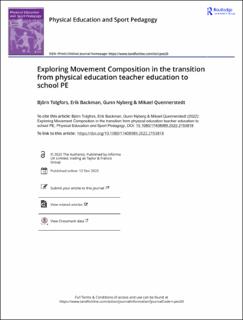| dc.description.abstract | Background: Scholars have suggested that students’ views of what is important for them to know as Physical Education (PE) teachers are a result of what is assessed in Physical Education Teacher Education (PETE). Thus, there is a risk that students will reproduce content areas such as sports and assess sport-techniques without much critical consideration. In this study, however, the risk of reproducing what is prioritised in PETE is seen as an opportunity regarding the potential reproduction of other content areas than sports. Based on the regulative principles of PE and PETE that privilege sport skills and hinder creative movement learning, we focus on a content area in PETE that provides opportunities for students to engage in creative collaboration and examine how this content area is realised in school PE. Hence, we have chosen to explore ‘Movement Composition’, a content area which has a long tradition at one of the PETE universities in Sweden. Based on an overarching interest in whether and how PETE matters, this exploratory study focuses on the potential transferability of Movement Composition as a particular content area in the transition from PETE to PE. Purpose and research question: The purpose of this study is to explore Movement Composition as a content area undergoing the transition from PETE to school PE. The research question is: How is the pedagogic discourse of Movement Composition constructed, recontextualised and realised in the transition from PETE to school PE? Methods: Data was generated through an interview with one of the initiators of Movement Composition. Stimulated Recall interviews and Zoom interviews were also conducted with a group of five PETE students and three experienced PE teachers. In addition, documents such as the study guide, course literature, and written assignments associated with Movement Composition in the PETE programme were included in the empirical material. In the analysis, the combination of Bernstein’s pedagogic device and the Swedish didactics of PE research tradition was used to identify the pedagogic discourse of Movement Composition in the transition from PETE to school PE. Findings: The findings show how the pedagogic discourse of Movement Composition as a content area is constructed, recontextualised and realised in the transition from PETE to school PE. The construction of Movement Composition as a pedagogic discourse in PETE is about how the content area (the what) is selected and organised for pedagogical purposes. The recontextualisation of Movement Composition is about how the pedagogic discourse is interpreted and translated in relation to the PE syllabus. The realisation of Movement Composition involves how the content area in PETE is implemented in PE practice. Conclusions: This exploratory study has shown that what is articulated as a relevant content area and the way it is taught, learned, and assessed in PETE in many regards survives the transition to school PE. The transition from PETE to school PE does not only involve reproduction of sports and sport-techniques from one context to another. PETE also contributes to the use of creative, collaborative, and student-centred learning tasks in school PE. | en_US |

